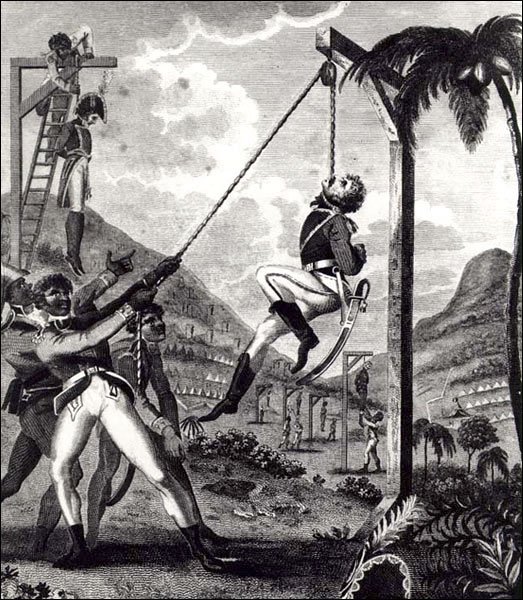The most successful slave revolt
"Battle of San Domingo," also known as the "Battle for Palm Tree Hill." Credit: January Suchodolski, Public Domain, Link.
A Fight for Freedom
In 1791 enslaved Black Haitians instigated a revolt which would lead to the start of the Haitian Revolution. In 1803 the Haitian Revolution began in earnest. The Revolution ultimately ended slavery and French control in the colony. The French Revolution had a significant impact on the Haitian Revolution as it led to a new definition of human rights, citizenship, participation and government.
Wealth & Capitalism
In the 18th century, Haiti, then known as Sainte Dominigue, was France’s wealthiest overseas colony due to the production of sugar, coffee, indigo and cotton generated by enslaved Black people. In Sainte Dominigue there were three main groups, plantation owners, the petit blancs (artisans, shopkeepers and teachers) and enslaved Black people. White plantation owners and the petits blancs were in favour of Haitian independence after France imposed steep tariffs on items imported into the colony. This plus the fact that white plantation owners couldn’t trade with any other nation besides France, furthered the agenda of revolution. Despite calls for independence, plantations owners and the petits blancs remained invested in slavery.
Haiti had a history of slave rebellions
In Sainte Dominigue there were three groups of Black people: those who were slaves, those who were free and those who had run away. In 1789, there were approximately 500,000 slaves and 30,000 free Black people on the island. Out of the 30,000 free Black people, half were biracial, and many were richer than the petits blancs. Slaves were never willing to submit to their status. In fact, a group of runaway slaves, known as maroons existed deep in the mountains of Sainte Dominigue in order to maintain their freedom. Haiti had a history of slave rebellions. For every 10 slaves there was just one plantation owner or overseer. Despite the harshness and cruelty of slavery in Sainte Dominigue there were slave rebellions before 1791. One plan even involved poisoning the plantation owners.
“Declaration of the rights of man”
The French Revolution’s “Declaration of the Rights of Man'' inspired several Haitain revolutionary movements. The General Assembly in Paris responded by enacting legislation which gave the various colonies some autonomy at the local level. The legislation called for “all local proprietors….to be active citizens,” which meant that free Black people who were substantial property owners were allowed to be a part of the government. However, the legislation excluded the petits blancs from government. This resulted in a three-sided civil war which included the petitis blancs, white plantation owners and free Black people. Enslaved Black people who were also inspired and affected by this legislation, posed a substantial challenge to all three groups.
Dessalines orders the slaughter of the remaining French residents in Haiti after promising them protection. Blacks and mulattoes, most of them former slaves, exact revenge on the whites and as many as 4,000 are killed. They are urged on by Dessalines, who famously cried, "Koupe tèt, brule kay," meaning, "Cut their heads, burn their houses."
Toussaint l’overture
On August 21, 1791, former slave Touissant L’Overture led enslaved Black people in a rebellion against the plantation owners. By 1792, the Black slaves controlled a third of the island, but the French and the British sent soldiers to try and defeat them. It was a bloody battle, 1000 Black people and 24,000 white people were killed. The Black soldiers managed to stave off the British and French forces, conquering them in 1798 after a series of defeats.
L’Overture was key in expanding the rebellion, in 1801 he conquered the neighboring Spanish colony of Santo Dominigo, (present-day Dominican Republic). L’Overture abolished slavery in the Spanish-speaking colony and declared himself Governor General over Haiti and the Dominican Republic.
january 1, 1804
The Haitian Revolution outlasted the French Revolution which it had been inspired by. Napoleon Bonaporte now the ruler of France, dispatched General Charles Leclerc and 43,000 French troops to capture L’Overture in order to restore French rule and revive slavery. Leclerc captured L’Overture, and he died in a French prison in 1803. However, the battle didn’t end with L’Overture’s death, one of L’Overture’s generals, Jean-Jacques Dessalines permanently defeated the French at the Battle of Vertieres on November 18, 1803. On January 1, 1804, Dessalines declared the nation independent and renamed it Haiti. Haiti became the first Black republic in the world, and the second nation in the western hemisphere after the United States to win its independence from a European power.
women warriors of haiti: untold history
Black women in the French-speaking world often lacked autonomy, and the fight for independence often overshadowed the seemingly secondary struggle for equality between the genders. The absence of documentation of women’s lives during the revolution comes at a cost. Although slavery was abolished by France during the French Revolution, many of the gains were eliminated when Napoleon took over as emperor. Even after Haiti achieved independence in 1804, it would not be recognized as a country by the major European powers for over a century. The United States did not recognize Haiti as a country until 1862. Haiti was also saddled with a crippling debt to France, which would eliminate Haiti’s ability to have a thriving economy. The outcry to see more women of color reflected in Haiti’s history is slowly shaping scholarship.
To find more works by or about Women in the Haitian Revolution: Haiti--History--Revolution, 1791-1804
Sanité Bélair, lieutenant in the army of Toussaint Louverture.
CITE THIS ARTICLE IN APA FORMAT:
Sutherland, C. (2007, July 16). Haitian Revolution (1791-1804). BlackPast.org. https://www.blackpast.org/global-african-history/haitian-revolution-1791-1804/
SOURCE OF THE AUTHOR'S INFORMATION:
Thomas O. Ott, The Haitian Revolution 1789-1804 (Knoxville, Tennessee:University of Tennessee, 1973); http://www.pbs.org/wgbh/aia/part3/3p2990.html.







